Indiana Amish
Your guide to the Amish in Indiana
 Indiana is home to the world’s third-largest Amish population. The state has long been important for the Old Order Amish. The “Plain People” have lived in Indiana for close to two centuries. Today, the Amish in Indiana form a vibrant and growing community. As of 2023, you’ll find them in over two dozen locations across the state.
Indiana is home to the world’s third-largest Amish population. The state has long been important for the Old Order Amish. The “Plain People” have lived in Indiana for close to two centuries. Today, the Amish in Indiana form a vibrant and growing community. As of 2023, you’ll find them in over two dozen locations across the state.
“Swiss”, Swartzentruber, and Lancaster, PA-transplant Amish are among the diverse groups of Amish Country Indiana. Today the Hoosier State has an Amish population of over 62,000 people. Read on to learn more about Amish communities in Indiana. Updated June 2023
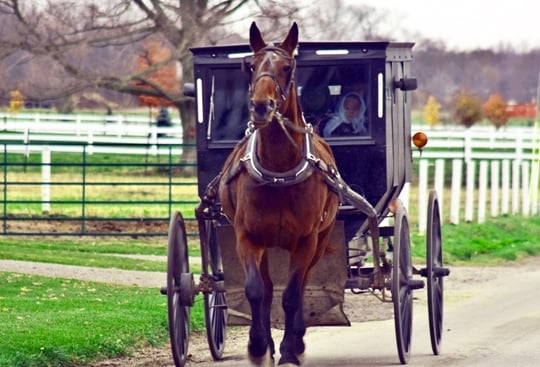
Amish Communities in Indiana
From the youngest Amish settlements in the southern end of the state to the oldest and largest at Elkhart-Lagrange Counties (over 28,000 Amish) in the north, Indiana is home to a wide diversity of Amish groups.
- Lagrange-Elkhart Counties – the northern Indiana community is easily the largest settlement in the state. The town of Shipshewana draws many visitors to this Amish Country destination
- Nappanee – a stone’s throw from the Lagrange-Elkhart settlement and third-largest in Indiana
- Adams County (Berne) – the Hoosier State’s second-largest community and an example of a Swiss Amish group
- Allen County – another Swiss Amish settlement a short distance from the Adams County community
- Daviess County – the sizeable southern Indiana group features Dinky’s auction house and a wide range of small businesses
- Pennsylvania Amish in Indiana – In the 1990s two groups of Amish left crowded Lancaster County, PA for the Hoosier State
- Other Indiana Amish communities – Indiana has around a dozen more settlements of a few church districts or less in size
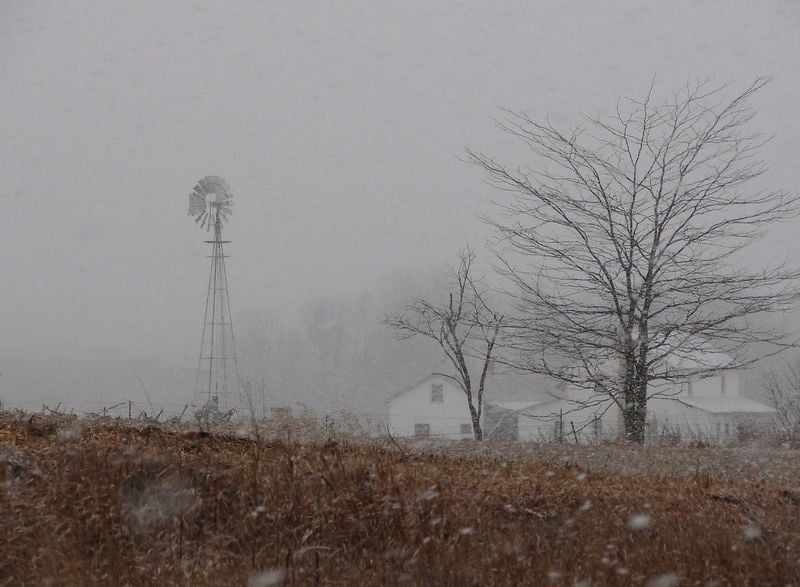
Lagrange – Elkhart Counties
The settlement at Elkhart and Lagrange Counties is the largest, oldest (founded 1841), and best-known community of Indiana’s Amish Country. Amish occupy the eastern portion of Elkhart County and the western half of adjacent Lagrange County (where they constitute over a third of the highly rural county’s population). Roughly centered around the popular tourist center of Shipshewana, the total Amish population in this community is approximately 28,000, spread over roughly 210 separate congregations.
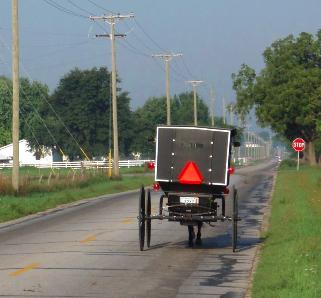
Elkhart-LaGrange differs from Holmes County, Ohio, in that it is home to a single affiliation of Amish (an affiliation is a loose collection of Amish churches who worship together and interact in other ways). While generally considered a progressive community, it does have a number of quite conservative Amish churches as well.
The more conservative groups are generally found on the eastern side of the settlement. This creates some distinct differences; for instance the gasoline-engine lawnmowers commonly seen in the western half of the settlement give way to rotating reel push-mowers in the east.
Full-time farming is not common in this settlement. Rather, Elkhart-LaGrange is highly oriented towards factory work. The majority of Amish household heads here find employment in the local recreational vehicle industry.
Many RV companies are headquartered in the area, and employ heavily-Amish workforces. In recent years, due to economic difficulty and high fuel prices, the RV industry has struggled. The many layoffs occurring in the industry have forced some Amish to shift into small business.
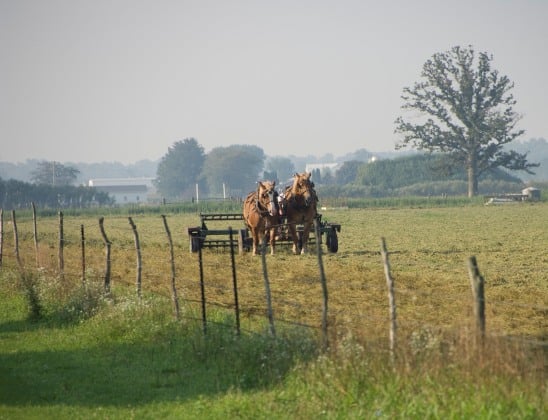
Farming has also declined to low levels, as in other Amish settlements. However the occasional Amish-owned dairy can still be found. In addition to milk production, there are a number of hog and poultry producers raising chickens, turkeys, and ducks in this community. Produce farming has also become popular for some Amish, particularly in the eastern end of the community, with a local auction offering an outlet for Amish fruits and vegetables.
The Elkhart-LaGrange community was featured prominently in the 2002 Rumspringa documentary ‘Devil’s Playground’. It is also home to the Shipshewana Flea Market, an event which draws thousands weekly to the tiny 500-person hamlet. The flea market is held every Tuesday and Wednesday from 8am to 4pm (May thru September).
The main towns in this settlement include Shipshewana, Middlebury, Topeka, and Millersburg.
Nappanee Amish Community
Also found in northern Indiana, the well-known community at Nappanee is located a few miles to the southwest of the Elkhart-LaGrange settlement. The Amish at Nappanee are similar in lifestyle and church rules to those in the LaGrange settlement. Though it was founded at around the same time, Nappanee is much smaller, with an Amish population of about 6,500 as of 2023.

With the continuous outward spread of this settlement and the Elkhart-LaGrange community, the two communities have in a sense “met” forming one contiguous settlement rivaling Lancaster County in size. Even in 2006, Amish settling in the region between the two communities were faced with the choice of which settlement to attend church in. Despite their geographical merging, the two settlements remain distinct from one another.
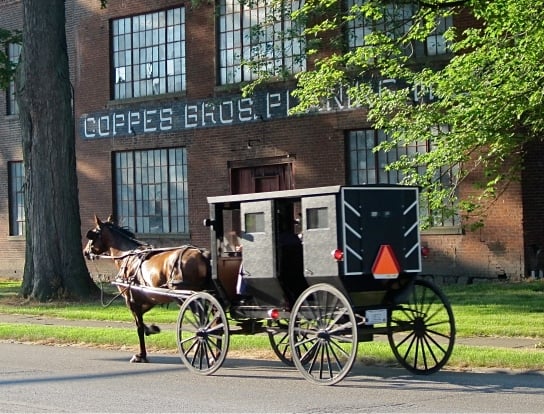
Nappanee is another tourist favorite, with the attraction The Barns of Nappanee (formerly Amish Acres) off the main drag west of town. Not far to the north of Nappanee, at Wakarusa is also found a small horse-and-buggy Old Order Mennonite community. Old Order Mennonites are similar to Amish in some beliefs and practices but outwardly-differentiated by their plain but patterned clothing, lack of beards, and (in some cases) use of public electricity.
Adams County
Straddling Fort Wayne in the northeastern part of Indiana are two ‘Swiss Amish’ settlements, located at Allen and Adams Counties. The Adams County settlement is slightly older (1850) and the larger of the two, with 66 church districts as of 2023.
The Adams County group, which also takes in parts of neighboring Jay County, is centered around the town of Berne, a community founded by Swiss settlers in the mid-1800s. The area also features a tourist attraction known as Amishville, a camping resort featuring a number of tourist-oriented events such as hayrides and gospel concerts.
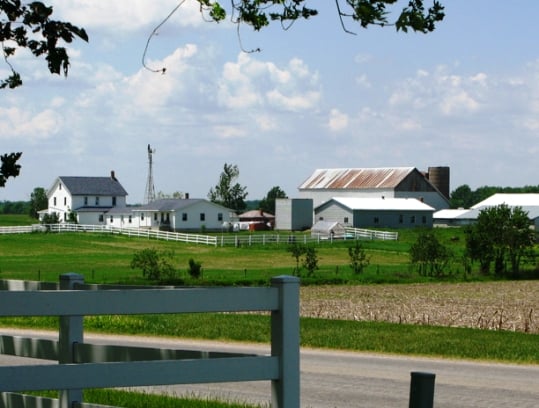
The Amish in Adams County are generally more conservative than those in the Elkhart-LaGrange or Nappanee communities, and are visibly plainer in practice and dress. Amish in this community have maintained a farming tradition to a significantly greater degree than those in the more progressive communities. The Swiss Amish of Adams and Allen Counties also have a specific history and set of customs rooted in their distinct heritage.
The Swiss Amish
The Swiss Amish of Adams County, like their counterparts in Allen County, have different origins than the majority of North America’s Amish. The ancestors of Amish in these and other Swiss communities arrived in America in the mid-1800s from Switzerland and surrounding areas.
Swiss Amish have maintained distinct customs and generally more conservative practices than the Pennsylvania German-ethnicity Amish today found predominantly in Pennsylvania, Ohio and other states.
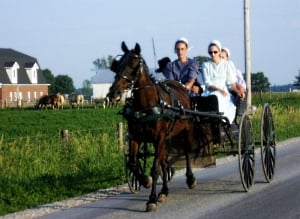
Swiss Amish only travel by open buggy. Swiss Amish in the Adams or Allen County communities speak different dialects of German from their cousins in Elkhart-Lagrange, Nappanee, and other Pennsylvania German Amish settlements. The difference between the dialects can be distinct – for example, a Pennsylvania Amishman noted that for better understanding, he actually spoke English with Amish in Allen County.
You may be familiar with ‘Miller’ and ‘Stoltzfus’ being common names among the Amish. Distinctive Swiss names are found in these settlements. For instance, ‘Schwartz’ is by far the most common surname in the Adams County community, with hundreds of households bearing the name. Other typical Swiss names include Graber, Lengacher, and Wickey. Swiss Amish have other distinct cultural markers, including the practice of yodeling as well as atypical burial customs. Read more on Swiss Amish.
Allen County
The Allen County group was founded about the same time as the Adams County community (1852), though is smaller (approximately 3,600 Amish as of 2023). In contrast to the Adams County group, the Allen County Amish have visibly higher standards of living, with fancier homes and carriages.
Many Allen County Amish have prospered in the construction industry, which is key to the Amish economy in this settlement. Full-time farming in this community has almost completely died out, and home shops and businesses are relatively few compared to other Amish settlements. Don’t expect to find very many of the typical Amish Country stores and shops to visit if you come to this community, but you will find some.
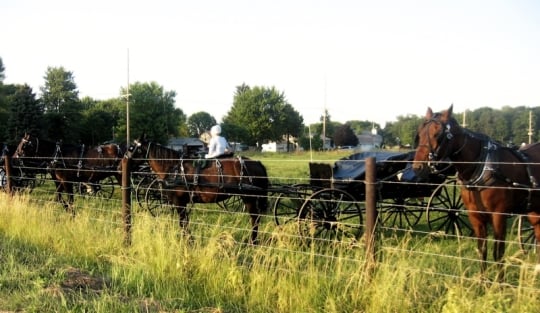
Interestingly, unlike most other Amish settlements in Indiana and elsewhere, brick is a popular building material in this community. Some Amish homes even employ faux-brick siding to achieve the desired visual affect. You tend to see a uniformity of construction styles in Amish settlements and among certain affiliations. This is quite noticeable in Allen County, with the homes reflecting the prosperity of the community. The Adams County Amish, in contrast, maintain a plainer appearance when it comes to their homes.
The Amish of Daviess County
Another Amish group with Swiss ties is located in the southern part of Indiana, in Daviess County (founded 1868; 5,800 Amish). The Daviess County group is not a fully “Swiss” group however; it’s made up of a mix of Swiss and Pennsylvania German-heritage Amish. Unlike the Adams or Allen County groups, Amish here use closed-top buggies a change they adopted in the early 1990s..
Daviess County Amish speak with a distinct southern twang that is instantly noticeable when members move to other communities. Daviess County Amish also have a reputation for friendliness. Even Amish in other communities in Indiana and elsewhere comment on the congenial nature of Daviess County Amish, which you might experience as well when meeting the locals.
Daviess County is located in a decidedly rural part of the state, full of dusty roads. Some of them turn to mud during downpours, so be aware. Small businesses such as furniture shops and construction crews are common in Daviess County. Dinky’s Auction Center is a local institution located in the middle of the community. Weekend auctions at Dinky’s are a popular draw for Amish and non-Amish alike.
Lancaster County Amish in Indiana
In 1991, gray buggies first found their way to Indiana when Amish from Lancaster County, Pennsylvania relocated on the western edge of the state, forming a new community at Rockville in Parke County (1,700 Amish as of 2023). A few years later, a second Lancaster group set up shop on the opposite side of the state in Wayne County (1994; 1,550 Amish).
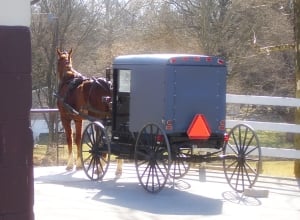
Amish in America’s best-known settlement have long faced population and other pressures, and migration is one way Lancaster Amish have maintained traditional lifestyles. Cheaper land and less-crowded roads have been strong draws for Lancaster County migrants to Indiana.
Notably, the Pennsylvania Amish migrants to Indiana decided on slightly different church rules that, for example, prohibited the growing of tobacco, commonly raised as a cash crop in the home settlement at Lancaster. Amish here maintain close ties with the Lancaster community, and are frequently “back-and-forth” with their mother settlement.
Indiana Amish Country: Other Communities
Though Indiana has close to three-quarters the Amish population of Pennsylvania, it has less than half as many communities (27 for Indiana vs. 60 for Pennsylvania). This reflects the fact that Amish in Indiana reside in more concentrated areas making for larger-sized settlements on average.
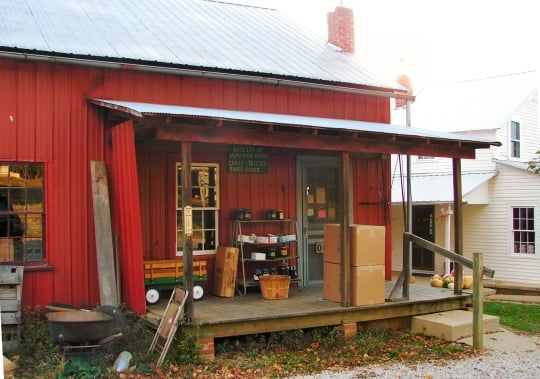
Indiana does have a fair share of smaller communities, however, with well over a dozen comprised of just three congregations (church districts) or less. In fact, he third-oldest community in the state is actually one of Indiana’s smallest. The settlement at Kokomo in Howard and Miami Counties was started in 1848, experiencing periods of growth and decline over its long history. Today the community is only two church districts in size. For different reasons, some Amish communities grow and flourish, while others do not.
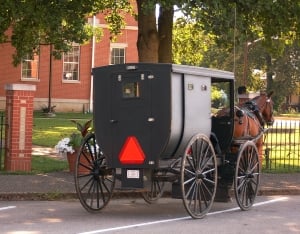
Indiana also exhibits a diverse Amish population. The state is home to conservative Swartzentruber Amish in Orange County (1994, four districts), as well as another conservative but unrelated group in the same county at Paoli (1957, three districts).
Other small Indiana communities include Milroy in Rush County (1969, four districts) and Swiss daughter settlements at South Whitley in Whitley County (1974, two districts), Salem in Washington County (1981, one district) and Vevay in Switzerland County (1986, three districts).
Amish Indiana: At Home in The Hoosier State
Indiana, Ohio and Pennsylvania together make up America’s “Amish Heartland”. These are by far the three most important states when it comes to the Amish. Roughly 65% of the total Amish population live in these three.
And despite recent migration by Amish in recent years to less-populous areas of the country – such as the western and northern states, Indiana keeps its position as a leading state for Amish settlement. With its abundant farmland and relatively low population density, Indiana remains an attractive place for Amish to live, with a steady rate of growth over the past decade.
For further information, see:
- Plain Diversity: Amish Cultures and Identities, Steven M. Nolt and Thomas J. Meyers
- An Amish Patchwork: Indiana’s Old Orders in the Modern World, Thomas J. Meyers and Steven M. Nolt
- “Amish Population 2022” Young Center for Anabaptist and Pietist Studies, Elizabethtown College https://groups.etown.edu/amishstudies/statistics/population-2022/
- “Amish Population in the United States by State, County, and Settlement, 2022” – Annual population figures compiled by Edsel Burdge, Jr., Young Center for Anabaptist and Pietist Studies, Elizabethtown College, in cooperation with Joseph F. Donnermeyer, School of Environment and Natural Resources, The Ohio State University, and with assistance from David Luthy, Heritage Historical Library, Aylmer, Ontario.
Photo credits: Shipshewana buggy-Anita Ritenour; Elkhart-Lagrange Amish buggy; Amish team in field-Northeast Indiana Regional Partnership; Nappanee buggy-ChicagoGeek; Berne Amish-Manuel Reinhard; Swiss Amish women; Grabill Indiana carriages-Renee Johnson; Southern Indiana Amish store-Cindy Seigle; Vevay Amish buggy-Kendal Miller, Switzerland County (IN) Tourism


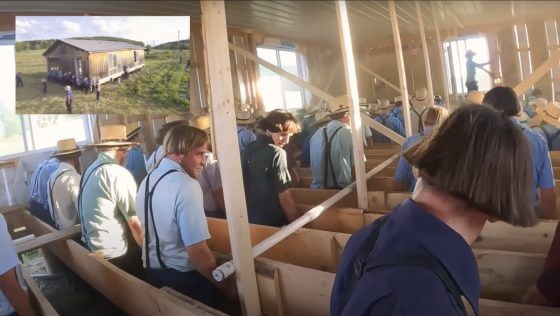

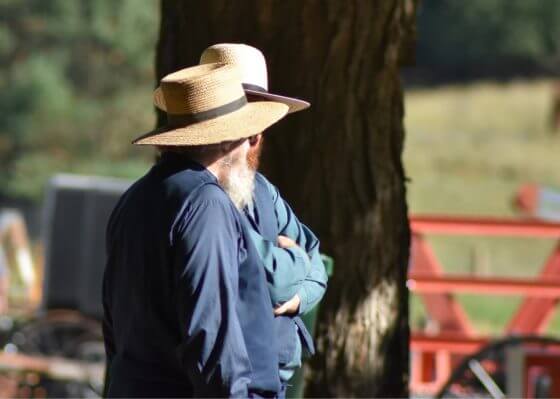

Parke County Amish Variety Store
Thank you Don. It has grown by 2 or 3 districts since I was there 10 years ago.
Parke County is famed for its covered bridges, which is evident by the domain name for the county visitors’ commission website: coveredbridges.com.
I was only there briefly so didn’t see many of them, but it apparently has 31 of an original 53 bridges remaining, supposedly the most of any county.
I’ll go ahead and put the info for the business you stopped at, for anyone who might want it.
Swarey’s Variety Store
3767 N 100 E
Marshall, IN 47859
Phone: (812) 653-9490
I live on a road in Paoli, Indiana and see a lot of nice Amish pass by house. We were told there was an Amish store with as lot of great food etc passed our house but have yet to find it. Do you know any Amish food stores in Paoli? Please help
Anita — In the Paoli area, there are two groups of Amish — the
Swartzentruber Amish and the “Paoli Amish”. The Swartzentruber
group is north and mostly west of Paoli, concentrated around CR 500 N and CR 200 W. To get to Petershiems Variety, turn west on 500 N. and go about three miles.
There used to be a sign stating “Variety and Harness Shop Stores”
on the corner where you turned south, but I’m not sure the sign is
still up. On 500 N. you will see signs on several Amish farms listing things for sale — like felt hats, eggs, firewood, etc. Stop at one of those and ask how to get to Petershiems. It’s not far from those other farms.
In the Paoli Amish settlement, I don’t know of any Amish store as
such, but if you go up Lynd School Road off Hwy 56, there are a couple of farms that sell produce/syrup/honey,etc.
If you’re ever over Daviess County way, there are several good Amish stores there. Also in Washington County at Rosebud is an
Amish Salvage Food/Bulk Food/Variety Items store. Friendly people,
easy to talk with.
Hope this helps! You don’t live far from several good Amish stores.
Free ride between Amish communities along a Kansas to Maine (and return) route
I am driving from Lawrence, Kansas to Holmes County, Ohio stopping there to visit my brother in Millersburg before driving on to Freedom, Maine, which is beside the new Amish communities in Thorndike and Unity. I am not asking any monetary compensation, and would be willing to drive a bit out of my way to pick up as many as three passengers for any leg of the trip or return. My departure date from Kansas is Wednesday January 28th and I will be leaving Maine on February 9th. Of course severe weather could slightly delay or modify those plans. Anyone in a position to pass on this invitation to Amish communities generally along this route or who have suggestions about how I might make this offer available to interested Amish who would like to travel to any of the communities generally between these destinations please respond and I will share contact information and character reference if desired. This is being posted in several state listings between Maine and Kansas.
Hi Erik, wonderful post about the home community of my mother in Daviess County and a great website.
Thank you so much for your committment to accuracy in writing about the Amish. That being said, this historian has a very small quibble about the difference between Swiss Amish and Pennyslvania Dutch Amish. You are correct that Swiss Amish are distinct because they immigrated directly from Switzerland. The Pennsylvania Dutch Amish are not originally from France and Germany however! They also all originited in the Swiss Cantons of Zurich or Bern, but had moved to Germany or the then German regions of today’s France as refugees. Apparently intermarriage or conversion in these temporary homes was negligible.
This intermediate stop in southern Rhine area of Germany and Alsace is partly responsible for the southeast German influence on the Pennsylvania Dutch language. The other element is of course the “Fancy Dutch”, or the Protestant and Catholic German settlers in Pennsylvania. The Amish used to be a small minority of Pennsylvania Dutch speakers.
Thanks Jadon, I appreciate the kind words. And thanks for raising this point.
In the text above, I don’t think I explicitly say they were originally from France/Germany, though I don’t think I used the best wording.
I do use the term “ancestry” though to reference those countries, (“with ancestry in France, Germany and elsewhere”) which is more vague. I believe that when I wrote this article I did that to reflect where their ancestors lived before emigrating to North America, and not necessarily their ethnicity, even though as you note their origins go back further.
Since the focus of this page is Indiana Amish and this is just a brief side note and not meant to explain PA German Amish from a historical standpoint I just cut it to prevent confusion. There are certainly other sources and articles available elsewhere that will explain that history much better. Thanks for the quibble.
This is true!
From the article above: “Daviess County Amish speak with a distinct southern twang that is instantly noticeable when members move to other communities. Daviess County Amish also have a reputation for friendliness. Even Amish in other communities in Indiana and elsewhere comment on the congenial nature of Daviess County Amish, a fact which holds true on meeting the locals”.
I have had the opportunity to speak to two Amish business owners from Daviess County, IN within the past couple of weeks. The first thing that I noticed was that their accents were very flat to southern. Nothing like I have ever heard from any Amish person that I have spoken with before.
The next thing that I noticed was how congenial they both were. I’d say that not only are they the friendliest Amish that I have ever encountered; they very well may be the friendliest two people that I have ever had the pleasure of speaking with. I had told my wife that I was going to be on the phone with one of them for “just a couple of minutes”. When I got off the phone I looked at my cellphone and I had talked with him just a few seconds short of 50 minutes! I almost NEVER stay on the phone for that long.
Time flies when you are having a conversation with someone that you can really relate to I guess. (We even found out that we have relatives with the same last name in our respective maternal family tree & they were even from the same part of Europe … The Alsace)
We will be in Daviess County for several days this summer for Horse Progress Days in early July. I am really looking forward to meeting these two gentlemen in person.
Great story Oldkat. I found the people there especially friendly too, glad to hear from others that I wasn’t off here 🙂 https://amishamerica.com/5-friendliest-amish-communities/
A little late, but finally got there.
In the above post from 2015 I thought that we would be going to Daviess County for Horse Progress Days in July of that year. It turned out that heavy rain at home as well as in Daviess County Indiana made that a bad idea. So, it didn’t happen.
However, Horse Progress Days made its cyclical return to Daviess County this year and I was able to fly to Indianapolis & drive down to Dinky’s Auction Center, site of the event. Spent three days there and had a wonderful time.
Met some fantastic people, Plain & “English”. In fact, I enjoyed it so much that we are kicking around the idea of driving to Indiana in October to visit the Auburn-Cord-Deusenberg Museum in Auburn, Indiana and then dropping in on Daviess County to pick up some items that I purchase while I was there.
And, yes, even to Texas ears those accents have a pronounced Southern twang to them.
Blacksmith
Hi Eric,do you have any information on William Arthur Amos? He was a blacksmith in Topeka, until he retired in 1958. He was my Great Grandfather. Any information would be greatly appreciated
I don’t have any info, sorry there. The only thing I can say is that I’ve never heard Amos as an Amish surname.
Ohio Amish
Which communities specifically came from Ohio? My ancestors moved from Holmes County to Indiana. My gr gr grandfather left the order before moving on to Missouri. I’d love to connect with anyone that shares our family tree.
Tours
Do any of the Amish Farms in Adams or Allen County open their homes/farms for tours?
Not in Adams county and it’s even less likely in Allen county. Allen county tends to be more suspicious of outsiders than Adams county. If you want to learn more about the Adams county Amish and perhaps build a relationship that would end in a home tour, I’d recommend you visit Schwartz’s shoe store. The owner is a 74 year old deacon named John Schwartz. John is a wonderful person, very friendly, open to outsiders and I’d have no problems showing up at his little store and telling him you want to learn more about the Amish there on berne. Within The Adams County community there are two primary divisions, one being more conservative than the other. I usually just look to see if there are kitchen cabients, and that tells me what division they are in. There are several subgroups there, so I am over simplifying it. I find Adams county much more interseting the Allen county. Allen county tends to be much more affluent with a level of technology that in some ways eclipses the large settlement of Elkhart-lagrange. For example it’s not unusual to be visiting in Allen county and have an Amish person pull a cell phone out of their pocket to take a call. While Adams county is far more conservative, they don’t even have phones and correspondence is done by mail. Adams county uses oil lamps, outhouses, no freezers, no running water in the house sans a hand pump, dry sinks, etc. we also find the people of Adams county to be much more inviting. I hope you have an opportunity to them. The Clocktower Inn has an Amish business listing on their website where you can find the address for Schwartzs Show store.
Siting
Nolt Family Dinner Haus
Pat, the closest thing I know is
Nolt Family Dinner Haus
12530 Cuba Road
Grabill, IN 46741
Phone: (260) 466-4224
Open Friday and Saturday for dinner (evening).
Nolt’s is a working farm with many buildings. They serve people in a converted buggy shed next to their home.
Owner David Nolt is Amish, formerly a plain Mennonite.
Maybe you could call ahead to see if they still offer buggy rides.
In Dec. 2013, a reviewer said:
“David and Barb Nolt, along with other family members and Amish community members strive to provide a genuine atmosphere and delicious home cooked meals on their family farm at Cuba and Trammel road. While Barb manages the guests and workers inside, David will gladly give a buggy ride for a nominal fee or show you his horses in the barns. Their daughter Mary May has made the many pies and deserts fresh the same day they are served from scratch using family recipes. For many years the family and workers would stop at 8:00 PM and gather in the back room to sing favorite songs A Capella with their beautiful voices for those who are still eating the meal. It was a time to rest and share in the love of Jesus through song. Whether you want to serve yourself with the Buffet or order something off the menu, they have plenty of meat and garden fresh entrees available to satisfy even the hungriest appetites. ”
http://www.urbanspoon.com/r/148/1442459/restaurant/Fort-Wayne/Nolt-Family-Dinner-Haus-Grabill
https://www.youtube.com/watch?v=hyJg3ROfAlQ
(Nolt Family Dinner Haus yodeling :29)
Linda,
Thanks for sharing the information. I’m curious about David Nolt. Do you know if he had been a member of the Wenger Mennonites from the a goshen area? I know there are some Nolts among the Wengers. I’d be interested to hear how he ended up as an OOA in Allen County. Do you know any more about his story?
David Nolt
Shipshewana, yes, at one time David was with the Mennonites from the Goshen area. Then he drove taxi for the Amish, and that is how he met his wife.
genealogy
I am looking for information regarding how to research Amish ancestors in Daviess County and Allen County, specifically Amish immigrants from France (Allen County). Thanks.
Amish groceries near Chicagoland
I enjoyed getting my groceries from Amish stores, but I live now in Chicago. Does anyone know of areas near the northern IL-IN border that sells Amish food products, produce, etc.? Thank you.
Amish products near Chicago
Martina,
Nathanel Stutzman from Arthur takes a load of locally produced farm products to the Chicago area on a regular basis. I believe customers can place their order ahead of time and meet him at the drop off location. His number is 217-254-0042. He may have access to email at stutzmanfamilyfarm@gmail.com. Nathanel is a great guy.
Mike
Amish groceries near Chicagoland (July 30th, 2015 at 13:06)
Thank you Mike.
I will follow-up on your lead.
Best,
Martina
Amish at Chicago markets
Martina, you are within about 2 hours of Shipshewana in Northern Indiana.
Rise ‘N Roll Bakery from Middlebury, IN, goes to some Chicago Farmer’s Markets:
http://risenroll.com/chicago-markets/
Amish Markets in Illinois:
https://amishamerica.com/amish-markets-illinois/
Amish people from Indiana take their baked goods to three Wednesday farmers markets in the Chicago suburbs:
(Palos Heights Farmer’s Market, Yoder Bakery)
http://www.palosheights.org/government/brads/testdept/FarmersMarket.asp
(Oak Lawn)
http://www.oaklawn-il.gov/residents/farmer-s-market
(Riverside Farmers Market, Yoder’s Bakery)
https://www.facebook.com/photo.php?fbid=796396820393202&set=pb.144040902295467.-2207520000.1405221238.&type=3&theater
Granola picture:
https://www.facebook.com/Riverside.Farmers.Mkt/photos/pb.144040902295467.-2207520000.1439642305./1018732531492962/?type=3&theater
Apple Pie:
https://www.facebook.com/Riverside.Farmers.Mkt/photos/pb.144040902295467.-2207520000.1439642140./1022513624448186/?type=3&theater
john y. miller.
looking for descendants of him. died in 1924 maybe middlebury. I have a book that was his about Jacob denner. printed in 1751. any interest or ideas what todo with it. any amish from his line yet?
Amish History Library / Historian
Yes! Call Floyd Miller 260-463-2401 ext 1. Floyd is the local Amish historian and is the curator of the Amish historical Library of northern indiana.
john y miller
so he may be interested in the book or other books I may have. Jacob gashos song book from west branch mi.?
Quite possibly. The Amish historical Library here maintains a collection of Amish Geneology books and historical artifacts (song books, bibles, letters, clothes, personal items) that have been donated to the library. There are many local Amish historians/collectors, but the library exists for the benefit of the community and those wanting to research their Amish Geneology. Floyd is very knowledgeable and would be happy to help you to research john y. Miller. I’m sure he can point you in the right direction.
ephraim j. s. miller
I guess the man could also give info on Ephraim miller and maybe there is a book out there of his offspring. I guess next time I go through shipshe I need to find him. thanks.
Take SR5 south of shipshewana and turn left (east) on 100S, that’s the road with the New Eden Care Center on the corner. Continue several miles east, perhaps 4-5 miles and you will see a set of buildings on the north side of the road and signs saying CreekSide wheel shop and another that says quality metal. Ask for Floyd. If you get lost just ask for Curve Roy’s Floyd. Anyone in the area will know who you are looking for.
Amish in Crawford County
There are quite a few Amish in one community in Crawford County, east of Grantsburg. I have done business with one family there, purchased wood and had furniture made. I believe they had originally split off from a group (either Wisconson or Iowa, can’t remember which) and were living on an old chicken farm while building several houses, one at a time. There is a harness and leather maker, furniture maker, felt hat maker and more, and of course, produce and the like. Good people, very honest to deal with.
I also have done business with Mr. Mose Yoder northwest of Paoli, he makes flooring from many types of wood. Good guy, very honest with great prices on raw wood flooring and trim. It’s not perfect stuff, but for the price you can’t beat it and there is always extra thrown in. He used to have a sign out on 37, but when they did construction to widen it, they took it down and it has not been up since. His “flooring” sign is still on 500 N. however. One of that same community, Sammie Miller, made all the doors for my new house. He is right on 500 N. and makes outdoor furniture from cedar, cutting boards and baskets, also a good person.
I would rather do business with the Amish. Trustworthy and good prices.
For older ladies.
My friend and I need to know about Amish near Richmond In. We are in our 70s and need somewhere that is easy to get to closest to Indianapolis and able to get back home without spending the night . Also my daughter is 50 but had heart surgery 6 years ago ( Aorta Valve replaced and had a stroke at the same time) We all use a cane or walker but would love to shop where things are made with Love. Hope you can help. We would be using I-70 east.
Wayne County Amish
Take 70 towards Richmond, then turn north on highway 27 towards fountain city. On the south side of fountain city is an Amish bulk foods store called Fountain City Acres. Great place to buy a deli sandwich and the Amish workers could post you to other Amish run businesses in the area. Hope you enjoy your visit!
Newburgh, IN
Are there any Amish Communitys near Newburgh, IN? I have seen some Amish gentleman stopping by for food at McDonalds but I haven’t been there for awhile. I am interested in finding about about their communities
Newburgh IN
Hi Jennifer, I also live in Newburgh and I have Amish heritage. There are no Amish communities in Warrick County. However, you may have seen some around Newburgh, because the Stolls and Grabers have booths at the Farmers Markets from May through September in Newburgh and Evansville.You also may have seen workers from Graber Post or cabinet makers. All would be from Daviess County Indiana.
Becoming a shed dealer
Hello Mike,
I would like to become an Amish Shed dealer in northern Indiana, who might I contact?
Thank you!
In the Oct. 31, 2018, edition of The Budget newspaper it was reported that the last Amish family has moved from Gosport, Indiana,(near Spencer in southwestern Ind.) so there is no longer an Amish community there. I don’t think the community ever got very large.
Note.
In adams county they do not bury amish men with their beards………………………………….they use shovels.
Eric;
What do you know about the Amish People in Rush Co. near Rushville?
I’m inquiring, because, my friends Dad was a Baker & Mortgage their farm.
Thanks
Milroy IN Amish (Rush County)
I’ve visited there once, it was 4 church districts at the time (2004 I believe) but I see it had dropped to 3 in the 2013 listing (haven’t checked a current year Almanac yet). Don’t know the reason for the decline. I think it was founded by a mix of people from more than one Amish group if I’m remembering the history right. It is also referred to as the Milroy community for the nearby town. Does your family have dealings with them now?
My Friends Dad Mortgage their Farms, now it’s been a min of 46 years ago, in 1973. It was before his death in 1974. And before, the original Rushville went through Hsrd Times & was brought out. The Amish, obviously haven’t change, however, tgey must go into Rushville by their English Neighbors Car, for Banking Business & to shop @ Walmart.
A footnote.the Amish backwards Thinking is; no updated Technology.
Yet, they won’t support, Ma & Pa Stores, if any our still in Business. Therefore, Eric, Walmart, Deliverly put the Ma & Pa out of Business. No more 1800s early 1900s dated Cash Resisters. How goes the Amish Peopke pay their bills. Checks have become a by gone ara. Perhaps they are allowed to have Debit Cards however, unlike Credit Cards, if they lose their Debit Cards, they must proved. With outbout a Flip a cell phone, they can’t call their Bank Immediately. And Eric, what’s goung to happen, when their Dated Phone Booth, goes dead permitted. Ok, that’s their believe, so be it. Their making it too difficult to communicate.
Amish on Route 3 in indiana
Back in the spring we went to Muncie Indiana and traveled up Route 3. There was an amish store on Route 3 but I can’t remember the name of the town so we can plan a trip to go back and visit it.
Amish store , highway 35 in Indiana
The little town there is called Losantsville and the place you want to go to years ago was a carpet outlet
Looking for information on how to start driving Amish around? Can you even make a living off of it around Hagerstown indiana?
Amish Mortgage their Farms in Rush Co. Now 50 yrs ago.
Eric;:
Please do some research re; The President @ the Ex Rushville National Bank in Rushville
Indiana. Mortgage Amish Farms. He’s been deceased for 45.5 yrs. & Anonymous.
It must had been extremely rare & unheard of, then and even these Internet days.
Obviously. The Amish People dated old fashion ways of thinking, the, obviously don’t believe in Electricity, yet, they’ll Except Personal Checks, having no clue. If the Persons account is for real or Fraudulent. My point is; how do they keep track of their bills? Surly, there allowed to have a Debut Card. Which is Obviously a Risk. Furthermore. Like Debut Card. Their Mortgage bill is Automatic taken out of their account(s) Please Explain.
Worship Services?
Are any of the Amish or Mennonite communities here open to the attendance of their worship services? We love to learn about others’ faith and worship practices. It would be amazing to see how they worship.
Also interested in Amish worship services!!!
Thank you so much, Dante, for posting your question about any possibility of being permitted to attend Amish worship services–it’s exactly what I have been yearning for for many years!! I just couldn’t find the words to say it, but you said it so well. If anyone knows if this would be possible for a non-Amish girl, please let me know. May God bless you all!!
Any Amish community in southern or middle of Indiana
I am currently in the process of moving to Mooresville, In and would like to purchase furniture, I would like it to be made by local economy and the Amish so I at least I know my money is going to support some one’s family, if any one knows of a local community could you please email me cmrd3709@yahoo.com
Amish Newspaper in Nothern Indiana?
Hello, I am looking to make contact with an Amish news publication or something along those lines in Shipshewana, Indiana. I am with the Indiana Sheep Association, and we are having an event there that we are told the Amish would be interested in. It involves raising sheep on a small scale. A while back we had an event that many Amish in theat area came to and seemed to enjoy. How might i get a notice in their newsletter or publication to let them know about it?
Amish in South Eastern Indiana
Hello, I live just outside of Cincinnati. I’m looking for an Amish community, hopefully nearby, where I can buy food, leather, wool and/ or lumber. Potentially other provisions as well. Thank you for any recommendations and God bless.
Looking for a builder
Hi, We live in Brooklyn Michigan, we are ready to build and are looking for a reliable Amish C. to build our house. Can someone give me a name or two who maybe interested in building our house in Brooklyn Michigan. Please email me names and numbers. I would greatly appreciate it.
Open top buggies
I was born in Washington Indiana which is in Davies County to couple whose parents were Amish. I had many rides in their buggy which had no roofs. We had to use tarpaulins to cover us during inclement weather. Are there still many of those around.